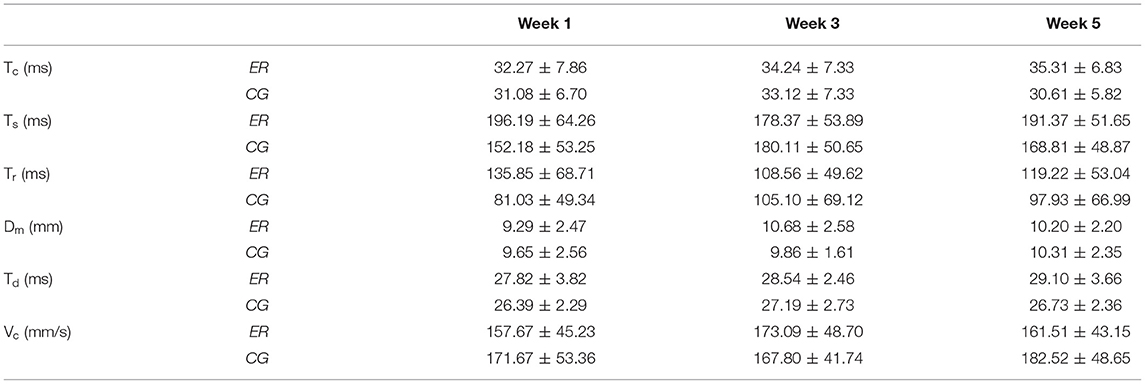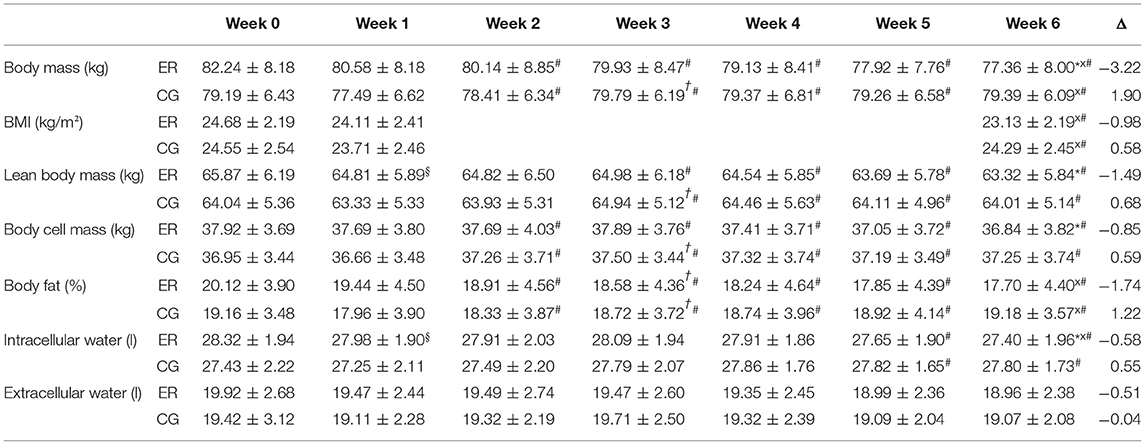- Department of Sports Medicine and Exercise Physiology, Institute of Sport Sciences, Goethe University Frankfurt, Frankfurt, Germany
A Corrigendum on
High-Protein Energy-Restriction: Effects on Body Composition, Contractile Properties, Mood, and Sleep in Active Young College Students
by Roth, C., Rettenmaier, L., and Behringer, M. (2021). Front. Sports Act. Living 3:683327. doi: 10.3389/fspor.2021.683327
In the original article, there was a mistake in Supplementary Table 7 as published. There was a computation error in Vc week 3, as well as a rounding error in Tr. The corrected table has been renamed “Supplementary Table 2” and appears below.

Supplementary Table 2. Overview of the TMG analysis [energy-restricted (ER) and control group (CG)].
In the original article, there were rounding errors as well as wrongly used signs in Table 2 as published. The corrected Table 2 appears below.

Table 2. Overview of body composition changes in the energy-restricted group (ER) and the control group (CG).
In the original article, there was a mistake in the legend for Supplementary Table 7 as published. Since the Vc values for week 3 were corrected due to a computation error, the sign for significance is no longer needed. The name of the table has been corrected to “Supplementary Table 2” and the corrected legend appears below.
Supplementary Table 2 Overview of the TMG analysis [energy-restricted (ER) and control group (CG)].
In the original article, the computation error in Vc as well as a rounding error in Tr have been corrected.
A correction has been made to Results, Contractile Properties, Paragraph 1:
For TMG, no significant differences were found for Ts (ER: Δ −4.82 ms; CG: Δ 16.63 ms), Tr (ER: Δ −16.63 ms; CG: Δ 16.90 ms) and Td (ER: Δ 1.28 ms; CG: Δ 0.34 ms, all p > 0.05). Although group allocation had no effect on Tc (ER: Δ 3.04 ms; CG: Δ −0.47 ms), Dm (ER: Δ 0.91 mm; CG: Δ 0.66 mm), and Vc (ER: Δ 3.84 mm/s; CG: Δ 10.85 mm/s) change, there appears to be an increasing trend in the ER group (p = 0.10) as well as in the ER and the CG (p = 0.066) for Tc and Dm over time, respectively (Figure 4; Supplementary Table 2).
In the original article, there was a rounding error in the body mass (ER group). A correction has been made to Materials and Methods, Participants, Paragraph Number 2:
Thirty-five healthy males with no experience in resistance training, as assessed by a pre-study questionnaire, were recruited from local sports clubs and University courses (see Figure 2). One participant declined to participate and three participants were excluded due to lacking protocol compliance (did not adhere to dietary intake). Finally, 28 healthy males (ER: age 26.57 ± 4.20 years; height 1.83 ± 0.05 m; body mass 82.24 ± 8.18 kg; CG: age 25.29 ± 2.97 years; height 1.81 ± 0.09 m; body mass 79.19 ± 6.43 kg) were used for data analysis. Due to hormonal fluctuations (Cumberledge et al., 2018), only male participants were included in order to increase reliability. The participants, who all reported that anabolic-androgenic drugs have never been consumed before, undertook at least two sport sessions per week. Since we only aimed for including lean participants, participants were excluded if their body fat was above 25%; this is the cut-off value for obesity, as suggested by Beals et al. (2019). During the study, the participants were asked to continue their habitual training. All participants were informed about the goal of the study as well as its conduction; in particular, interventional strains and requirements were highlighted. Every individual voluntarily agreed and gave written and informed consent to participate in the study.
The authors apologize for this error and state that this does not change the scientific conclusions of the article in any way. The original article has been updated.
Publisher's Note
All claims expressed in this article are solely those of the authors and do not necessarily represent those of their affiliated organizations, or those of the publisher, the editors and the reviewers. Any product that may be evaluated in this article, or claim that may be made by its manufacturer, is not guaranteed or endorsed by the publisher.
References
Beals, J. W., Burd, N. A., Moore, D. R., and van Vliet, S. (2019). Obesity alters the muscle protein synthetic response to nutrition and exercise. Front. Nutr. 6:87. doi: 10.3389/fnut.2019.00087
Keywords: fat-free-mass, Tensiomyography, muscle quality, sports nutrition, proteolysis
Citation: Roth C, Rettenmaier L and Behringer M (2021) Corrigendum: High-Protein Energy-Restriction: Effects on Body Composition, Contractile Properties, Mood, and Sleep in Active Young College Students. Front. Sports Act. Living 3:762606. doi: 10.3389/fspor.2021.762606
Received: 22 August 2021; Accepted: 29 September 2021;
Published: 08 November 2021.
Edited by:
Vassilis Mougios, Aristotle University of Thessaloniki, GreeceReviewed by:
Evelyn Parr, Australian Catholic University, AustraliaDonny Michael Camera, Swinburne University of Technology, Australia
Copyright © 2021 Roth, Rettenmaier and Behringer. This is an open-access article distributed under the terms of the Creative Commons Attribution License (CC BY). The use, distribution or reproduction in other forums is permitted, provided the original author(s) and the copyright owner(s) are credited and that the original publication in this journal is cited, in accordance with accepted academic practice. No use, distribution or reproduction is permitted which does not comply with these terms.
*Correspondence: Christian Roth, cm90aEBzcG9ydC51bmktZnJhbmtmdXJ0LmRl
 Christian Roth
Christian Roth Lukas Rettenmaier
Lukas Rettenmaier Michael Behringer
Michael Behringer